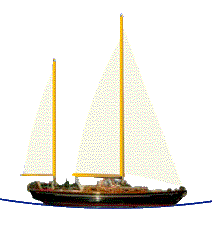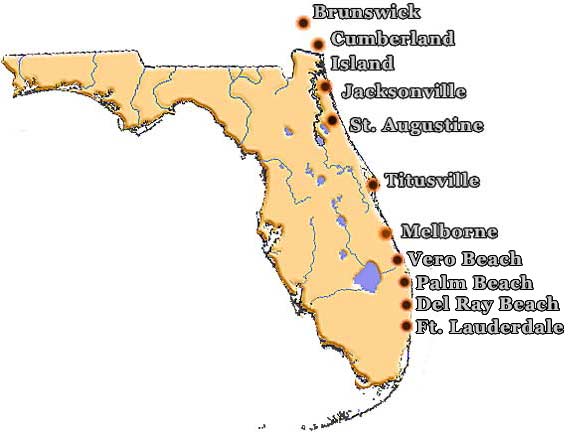
Ships Log
February 28 - March 8, 2006
Ponce de Leon Inlet, Titusville and Cape Canaveral, Florida
We arose before dawn to get an early start for our sail down the coast. The tidal current was raging. We have always found that we had sufficient power in reverse to back out into current. Unfortunately, this time it was not to be the case. We should have abandoned the effort and waited for slack tide, but we forced the issue and got Raven out just enough to swing over and come to rest across the stern pilings. There we stayed until the current subsided at 10:00 AM. We were able to get fenders between the boat and the piles, preventing damage to Raven. But our egos were bruised as friends and the rest of the marina stopped by to shoot photos and offer clever advice.
We had a wonderful sail down the coast. Seven miles off the coast at Flagler Beach, we saw our first cetacean. It was an Orca 100 feet off our beam traveling in the opposite direction, chasing a dinner of porpoise. Mike almost swallowed the camera trying to get a photo, but it was not to be. The Orca was larger than the boat and came as a complete surprise. We had been looking for Right Whales since this is designated the Northern Right Whale Critical Habitat, but we did not know Orca could be found here.
If we had been able to depart at dawn, we considered sailing well down the coast to Cape Canaveral Inlet. However, the late start and our coming down with a really good case of the flu, meant that we were going to fall short and reach the Ponce de Leon Inlet at dusk. The charts and harbor books indicated that the Ponce Inlet to New Smyrna was passable and that Lighthouse Harbor Marina, just inside the inlet had 8 feet of water. It was clear as we negotiated the inlet that it is not to be attempted in unsettled conditions. Luckily, the sea was fairly gentle. After rounding the point in the growing darkness, we turned into the well marked marina channel and immediately went aground. We backed out on the rising tide and later found that the channel had silted to under 5 feet. With our high power spotlight and local knowledge from the Lighthouse Harbormaster who kindly guided us over the radio, we picked our way in total darkness up the dangerously shallow backwater channel to Inlet Harbor Marina where we tied to the fuel dock and spent the night.
The next day, the wind had shifted to the south and was predicted to remain in that quadrant for a week. So, we decided to take the ICW to Titusville. We knew that the ICW was too shallow for us in Georgia and had been told that the Florida sections were deeper. But, we were nervous since we had no specific knowledge of this stretch. The only advice we got from the dockhand at Inlet Harbor was not to return the way we had entered, since "no boat your size could possibly pass that channel". We did encounter much shallow water, with the depth alarm sounding frequently, but once we reached the Haulover Canal we were fine.
The Titusville Municipal Marina is a true cruisers hangout. The boats anchored at the entrance and filling the slips are a colorful mix of eclectic seagoing craft. We were both quite sick with the flu and remained in this charming and reasonable marina for a week recovering. The only downside of the marina is the freight trains that screamed around the corner nearby at all hours of the night. They did not bother us, but they were the focus of jokes in the marina. Titusville was named by Col. Titus, the local postmaster who won the naming rights in a domino game with Captain Clark Rice in 1873. The town was previously known as Sand Point. Titus maintained a popular gathering spot called Titus House and he was responsible for the planting of live oaks all around the community.
Once we started feeling better, we ventured out to the local shrimp house called Dixie Crossroads. They are famous for their delicious extra jumbo white shrimp. Cape Canaveral white shrimp spend the first part of their lives in shallow inshore estuaries like the Indian River Lagoon and St. Johns River. In the fall, the adult shrimp move out of the bays and sounds of North Florida, Georgia and Carolinas into the ocean in large numbers. They migrate south and spend the winter in the shoals off Cape Canaveral, then migrate north again in the spring. White shrimp are sweet and tender due to the time they spend in freshwater. They were delicious!
One day, we rented a car and drove down to the space port at Cape Canaveral. Cape Canaveral, the name conjures images of "The Right Stuff", JFK, men in spacesuits and Tang; not to mention "I Dream of Jeannie". Everyone knows the countdown: 5, 4, 3, 2, 1, ignition, Blast Off! The dramatic liftoff of space rockets. Growing up as we did during the space race, we found it exciting to see the massive hardware. Mike can remember watching the sky with his Dad through his telescope as the Mercury/Redstone passed overhead.
On the way back, we stopped at the Policicchio Groves Indian River citrus stand. There, we sampled delicious grapefruit, oranges, kumquats and found our first Meyers lemons. Unlike the small dry lemons we have been accustomed to, when we cut into the large, round, thin skinned lemons the juice exploded.


